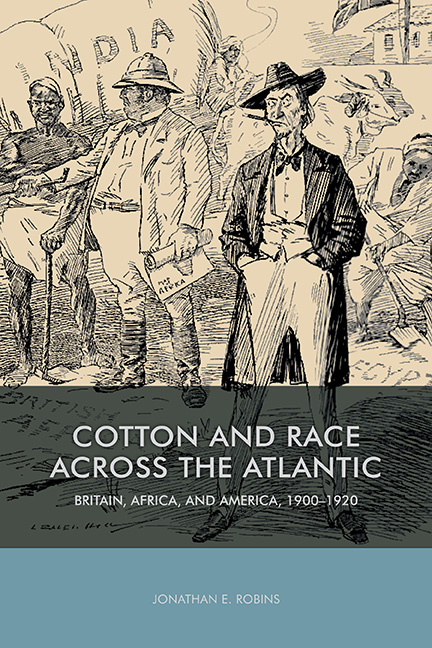Book contents
- Frontmatter
- Contents
- List of Illustrations
- Preface
- Abbreviations
- Introduction
- 1 The Cotton Crisis: Lancashire, the American South, and the Turn to “Empire Cotton”
- 2 “The Black Man's Crop”: The British Cotton Growing Association and Africa
- 3 “The Scientific Redemption of Africa”: Coercion and Regulation in Colonial Agriculture
- 4 “King Cotton's Impoverished Retinue”: Making Cotton a “White Man's Crop” in the American South
- 5 Cotton, Development, and the “Imperial Burden”
- Notes
- Bibliography
- Index
1 - The Cotton Crisis: Lancashire, the American South, and the Turn to “Empire Cotton”
Published online by Cambridge University Press: 13 July 2019
- Frontmatter
- Contents
- List of Illustrations
- Preface
- Abbreviations
- Introduction
- 1 The Cotton Crisis: Lancashire, the American South, and the Turn to “Empire Cotton”
- 2 “The Black Man's Crop”: The British Cotton Growing Association and Africa
- 3 “The Scientific Redemption of Africa”: Coercion and Regulation in Colonial Agriculture
- 4 “King Cotton's Impoverished Retinue”: Making Cotton a “White Man's Crop” in the American South
- 5 Cotton, Development, and the “Imperial Burden”
- Notes
- Bibliography
- Index
Summary
To understand the origins of the British Cotton Growing Association and its impact on Africa, we must follow the commodity chain of cotton to its centers at the beginning of the twentieth century: the southern United States and Lancashire. These sites were respectively the largest exporter of raw fiber and the largest exporter of finished fabric, and events in these places shaped the movement of the cotton industry across the world. The transatlantic relationship between American agriculture and European industry was made possible by the labor of African captives and their descendants in America, but as workers they had little ability to infl uence prices and other developments.
The turn of the twentieth century was an uncertain time for American cotton farmers, black and white, as well as for their trading partners in American and European textile mills. American farmers still dominated the world's cotton supply, but cotton prices were at their lowest point since the Civil War. Manufacturers were recovering from the depression that followed the “Panic of 1893,” and Britain's cotton mill owners were concerned about growing competition from rival European and Asian exporters. When cotton prices began to move upward in 1900, few took notice: most manufacturers were lamenting a new decline in textile demand, caused by horrific droughts and famines in places as distant as China and Brazil. The value of British textile exports to a key market like Brazil fell 40 percent between 1899 and 1901; exports to China and India fell only about 5 percent in value, but the quantity of goods sold fell by nearly three times that amount, as Asian consumers paid more for less cloth.
By 1901, attention shifted from demand to supply as prices for raw cotton shot up dramatically. Manufacturers slashed prices to prop up fl agging sales, but they were caught between stagnant demand and rising raw material costs.3 The cost of raw cotton was becoming an increasingly important part of the final price of textiles, and raw cotton prices were out of the control of European manufacturers. In Lancashire, all eyes were on the “margin,” the trade term for the difference between the cost of one pound of raw cotton and the sale price of the yarn spun from it.
- Type
- Chapter
- Information
- Cotton and Race across the AtlanticBritain, Africa, and America, 1900–1920, pp. 30 - 71Publisher: Boydell & BrewerPrint publication year: 2016

